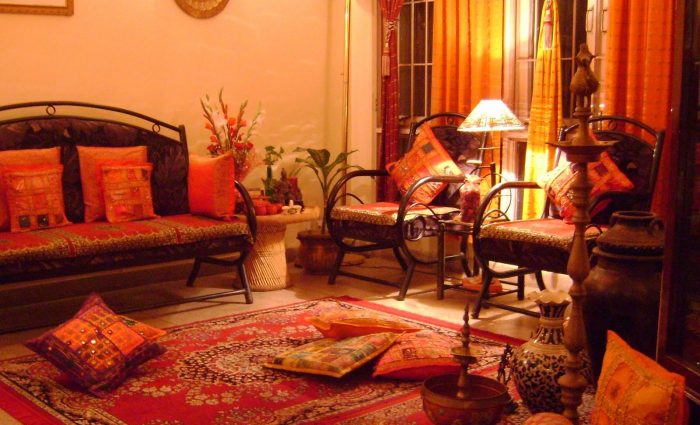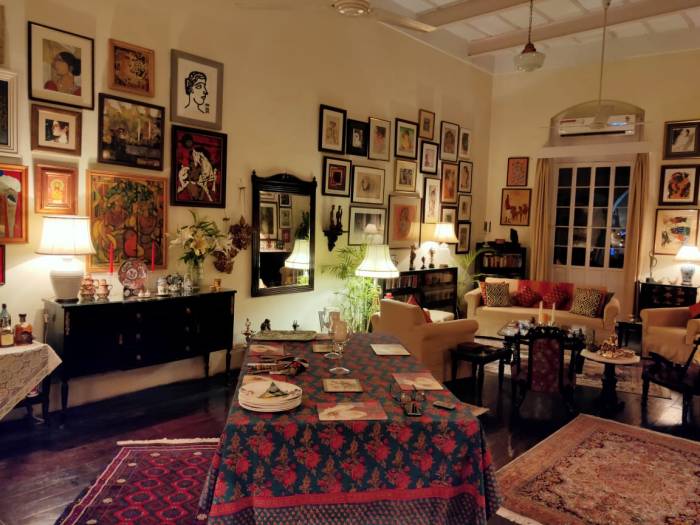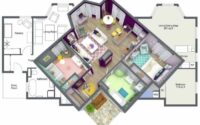Bengali House Interior Design: A Cultural Tapestry
Bengali house interior design is a captivating blend of tradition and modernity, reflecting the rich cultural heritage of the region. From the vibrant colors inspired by nature and art to the intricate details found in furniture and decor, Bengali homes tell a story of history, artistry, and family.
This article explores the fascinating world of Bengali interior design, unveiling the unique elements that define this distinct style.
Stepping into a Bengali home is like stepping back in time, where every element speaks to the region’s history and traditions. The use of natural materials like wood, terracotta, and textiles creates a warm and inviting atmosphere, while the intricate patterns and colors reflect the region’s vibrant artistic heritage.
Whether it’s the traditional cane chairs in the living room or the ornate brass lamps adorning the dining area, each piece tells a story and adds to the unique charm of a Bengali home.
Flooring and Walls

Flooring and wall treatments are crucial aspects of Bengali home interiors, reflecting the region’s rich cultural heritage and practical considerations. From traditional materials to modern innovations, these elements contribute to the overall aesthetic and functionality of a Bengali dwelling.
Terracotta Tiles, Marble, and Wooden Flooring
Terracotta tiles are a popular choice for flooring in Bengali homes, particularly in rural areas. Their earthy tones and durability make them suitable for both indoor and outdoor spaces. They are often used in courtyards, verandahs, and kitchens, adding a rustic charm to the environment.
Marble flooring, on the other hand, is preferred in more urban settings and for a more luxurious feel. Its smooth surface and elegant appearance enhance the grandeur of living rooms, bedrooms, and dining areas. Wooden flooring, especially teakwood, is also commonly used in Bengali homes, particularly in bedrooms and living rooms.
It provides warmth, comfort, and a sense of tradition.
Bengali house interior design often incorporates traditional elements like intricate wood carvings and vibrant colors. However, even in smaller spaces, these elements can be incorporated thoughtfully. For example, a 30 square meter house can benefit from clever space-saving techniques, like using a 30 square meter house interior design guide, to create a spacious and welcoming environment.
This approach allows you to maintain the essence of Bengali design while maximizing functionality and aesthetics in a compact space.
Traditional Wall Treatments, Bengali house interior design
Bengali homes often feature traditional wall treatments that showcase the region’s artistic heritage. Murals, paintings, and decorative tiles are common elements that adorn the walls. Murals, often depicting scenes from mythology, folklore, or everyday life, add a vibrant and narrative touch to the interior.
Paintings, ranging from traditional art forms like Patua and Kalighat to contemporary works, enhance the aesthetic appeal and cultural identity of the space. Decorative tiles, often made of terracotta or ceramic, are used to create intricate patterns and designs, adding a touch of elegance and craftsmanship to the walls.
Wall Decor Scheme with Traditional Bengali Patterns and Colors
A wall decor scheme inspired by traditional Bengali patterns and colors can create a visually appealing and culturally rich ambiance.
- Patterns:Traditional Bengali patterns, such as the “alpona” (freehand drawings using rice paste), “kalighat” (paintings on paper), and “tant” (woven patterns), can be incorporated into wall decor. These patterns often feature geometric shapes, floral motifs, and auspicious symbols, adding a touch of cultural significance to the space.
- Colors:Bengali aesthetics often favor vibrant colors like red, yellow, green, and blue. These colors, often found in traditional textiles and artwork, can be used to create a visually striking and lively atmosphere. For example, a wall painted in a warm terracotta shade could be adorned with a “kalighat” painting featuring bold red and yellow hues, creating a visually dynamic and culturally rich space.
Courtyard and Outdoor Spaces
Courtyards are an integral part of traditional Bengali homes, serving both practical and symbolic purposes. They offer a respite from the bustling city life, providing a serene and private space for relaxation, social gatherings, and spiritual reflection.
Traditional Courtyard Design Elements
Courtyards in Bengali homes are typically designed with a focus on natural elements and traditional aesthetics. Here are some common elements:
- Water Features:A small fountain, pond, or water body is often incorporated into the courtyard, adding a calming ambiance and symbolizing purity and prosperity.
- Seating Area:A traditional courtyard will usually have a seating area, often with a raised platform or a shaded verandah, providing a comfortable space for family and guests to gather.
- Plants and Trees:Courtyards are often filled with a variety of plants and trees, adding a touch of greenery and creating a sense of tranquility. Popular choices include mango trees, banana trees, and jasmine plants, known for their fragrance and symbolic significance.
- Traditional Architecture:The courtyard itself is often designed with traditional architectural features, such as a tiled roof, intricate carvings, and colorful murals. This adds a unique character and cultural significance to the space.
Examples of Traditional Bengali Courtyard Designs
Here are some examples of traditional Bengali courtyard designs and their cultural significance:
- The “Thakurdalan”:This is a traditional courtyard space dedicated to the worship of the family deity. It typically features a small shrine, often decorated with intricate carvings and colorful murals, and is a place of reverence and spiritual connection.
- The “Aat Chala”:This type of courtyard is characterized by its eight-pitched roof, a distinctive feature of Bengali architecture. It often features a central open space surrounded by verandahs and rooms, providing ample space for family gatherings and social events.
- The “Baramash”:This courtyard design features twelve different types of plants, representing the twelve months of the year. Each plant has a specific cultural significance, symbolizing different aspects of Bengali life and tradition. This design is a testament to the rich cultural heritage and connection with nature that is deeply ingrained in Bengali society.
Sustainability and Eco-Friendly Practices

In the pursuit of creating beautiful and functional Bengali homes, it is essential to consider the environmental impact of our design choices. Sustainable and eco-friendly practices are becoming increasingly important in all aspects of life, and interior design is no exception.
Bengali house interior design often features intricate details and a warm, inviting atmosphere. When designing a second floor, maximizing space and natural light is key. A well-planned layout can create a comfortable and functional living space. For inspiration, explore ideas for 2nd floor house design interior , which can help you create a beautiful and functional space that reflects your personal style.
These principles can be applied to enhance the overall aesthetic of your Bengali home.
This section explores how to incorporate sustainable materials and techniques into Bengali interior design, minimizing the environmental footprint of our homes while preserving the rich cultural heritage.
Sustainable Materials and Practices
The use of sustainable materials is crucial for creating eco-friendly Bengali homes. These materials have minimal environmental impact during their production, use, and disposal.
- Bamboo:A readily available and rapidly renewable resource in Bengal, bamboo is an excellent choice for flooring, furniture, and structural elements. Its strength, durability, and aesthetic appeal make it a sustainable alternative to traditional timber.
- Recycled Materials:Incorporating recycled materials like salvaged wood, recycled glass, and repurposed textiles reduces waste and promotes resource conservation. These materials can be creatively used for furniture, decorative elements, and even wall finishes.
- Locally Sourced Materials:Prioritizing materials sourced locally reduces transportation emissions and supports the local economy. This includes using stone from nearby quarries, terracotta tiles, and handwoven fabrics.
- Natural Paints and Finishes:Opting for natural paints and finishes made from plant-based ingredients reduces the use of harmful chemicals and volatile organic compounds (VOCs). These paints are often breathable and non-toxic, contributing to a healthier indoor environment.
Traditional Bengali Techniques for Energy Efficiency
Traditional Bengali architecture often incorporated features that promoted energy efficiency and reduced reliance on external energy sources. These techniques can be adapted to modern homes for a more sustainable approach.
- Courtyard Design:The traditional courtyard design, known as “Andar Mahal,” allowed for natural ventilation and passive cooling. The courtyard acted as a buffer, moderating the temperature fluctuations inside the house.
- Verandas and Balconies:These spaces provide shade and ventilation, reducing the need for air conditioning. They also act as transition zones, connecting the interior to the outdoors.
- High Ceilings:High ceilings allow for better air circulation and reduce the need for artificial ventilation. This is particularly relevant in the hot and humid climate of Bengal.
- Use of Natural Light:Traditional Bengali homes often incorporated large windows and skylights to maximize natural light, reducing reliance on artificial lighting during the day.
Designing a Sustainable and Eco-Friendly Bengali Home
Integrating sustainable practices into the design process is essential for creating a truly eco-friendly Bengali home. This includes:
- Site Selection:Choosing a site with existing vegetation or proximity to public transportation minimizes the environmental impact of the project.
- Water Conservation:Implementing water-saving features such as rainwater harvesting, low-flow fixtures, and drought-tolerant landscaping reduces water consumption.
- Energy Efficiency:Utilizing energy-efficient appliances, installing solar panels for electricity generation, and incorporating passive cooling techniques minimizes energy consumption.
- Waste Management:Promoting composting, recycling, and reducing waste generation is crucial for minimizing the environmental impact of the home.
Cultural Significance of Bengali Interior Design

Bengali interior design is not merely about aesthetics; it’s a reflection of the rich cultural heritage and deep-rooted values that define Bengali society. Every element, from the vibrant colors to the intricate patterns, speaks volumes about the importance of family, community, and traditions in Bengali life.
Bengali house interior design often reflects a vibrant blend of tradition and modernity. The use of warm colors, intricate details, and traditional motifs creates a welcoming and inviting atmosphere. When designing a larger space, like a 1800 sq ft house interior design , the key is to maintain this sense of warmth while ensuring functionality.
This can be achieved by strategically incorporating open floor plans, well-defined zones, and ample natural light to create a spacious and airy feel.
The Importance of Family and Community
The Bengali home is the heart of the family and community. It is a space where generations come together, celebrate festivals, and share stories. The interior design reflects this emphasis on togetherness. Open floor plans, spacious living areas, and well-equipped kitchens are common features, encouraging interaction and fostering a sense of belonging.
- Extended Families:Bengali households often include multiple generations living together, making it crucial for the interior design to accommodate everyone comfortably. This can be seen in the use of multi-functional furniture, such as sofa beds, and the presence of dedicated spaces for elders, like a separate sitting area or a prayer room.
- Festival Celebrations:Festivals are an integral part of Bengali culture, and the home is the central stage for these celebrations. The interior design often incorporates elements that are symbolic of different festivals, such as the vibrant colors of Durga Puja or the intricate designs of Pohela Boishakh.
- Community Gatherings:Bengali homes are not just for family but also for friends and neighbors. The open spaces and welcoming atmosphere encourage social gatherings and create a sense of community.
Last Word: Bengali House Interior Design
The beauty of Bengali interior design lies in its ability to seamlessly blend tradition with modernity. By embracing sustainable practices and incorporating contemporary design trends, Bengali homes can remain true to their heritage while adapting to the needs of modern life.
Ultimately, Bengali interior design is more than just aesthetics; it’s a reflection of a vibrant culture, a celebration of family, and a testament to the enduring power of tradition.
Top FAQs
What are some common colors used in Bengali interior design?
Bengali interior design often uses earthy tones like terracotta, ochre, and green, inspired by nature. Vibrant hues like red, yellow, and blue are also incorporated, reflecting the region’s rich artistic heritage.
How does Bengali interior design reflect family values?
Bengali homes are designed to foster a sense of community and family. Open layouts, communal dining areas, and spacious courtyards encourage interaction and togetherness. The use of traditional furniture, such as large seating arrangements and elaborate dining tables, reflects the importance of family gatherings and celebrations.
What are some popular Bengali architectural features?
Bengali homes often feature courtyards, verandahs, and balconies that provide natural light and ventilation. The use of intricate window designs, decorative tiles, and traditional murals adds to the architectural beauty of these homes.
How can I incorporate Bengali design elements into my own home?
You can introduce Bengali design elements into your home by using natural materials, incorporating vibrant colors, and incorporating traditional patterns and motifs. Consider adding a few pieces of traditional Bengali furniture, such as cane chairs or wooden chests, to create a unique and inviting atmosphere.



